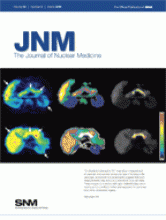TO THE EDITOR: With great interest, we read the recent publication by Nakagawa et al. (1). The authors studied enlarged, nonmetastatic cervical lymph nodes in oral cancer patients. The maximum standardized uptake value of the preoperatively performed 18F-FDG PET/CT was calculated, and the lymph node sections were immunohistochemically stained for glucose transporter type 1 (GLUT-1). The authors reported a positive correlation between the maximum standardized uptake value and both the number of secondary follicles and the reactivity index. Furthermore, the immunohistochemical staining pattern for GLUT-1 was markedly similar to the distribution of follicular dendritic cells and in secondary follicles was relatively localized in germinal centers. Therefore, the authors concluded that 18F-FDG–avid follicular dendritic cells might be the cause of 18F-FDG uptake in reactive cervical lymph nodes, resulting in false-positive reading of 18F-FDG PET images.
To our knowledge, the study by Nakagawa et al. (1) was the first assessing in detail the histologic basis of a positive 18F-FDG PET signal in reactive cervical lymph nodes. One question that arises is whether this observation is typical of oral cavity tumors. The oral cavity harbors a variety of nonpathogenic and (potentially) pathogenic microorganisms that can invade the body when the mucosal barrier is disrupted by an ulcerating tumor. This may thus cause reactive lymphadenopathy of first-echelon lymph nodes. In a similar study, Chung et al. (2) demonstrated GLUT-1 staining and positive 18F-FDG uptake in mediastinal hyperplastic lymph nodes in patients with non–small cell lung cancer. This finding suggests that the phenomenon occurs also in other tumors of epithelial origin.
The second question is whether this limitation of 18F-FDG can be solved with other PET tracers. In a previous issue of The Journal of Nuclear Medicine, we reported the role of 3′-deoxy-3′-18F-fluorothymidine (18F-FLT) in the detection of cervical lymph node metastases in patients with head and neck cancer (3). We correlated 18F-FLT uptake with immunohistochemical assessment of the proliferation markers Ki-67 and iododeoxyuridine. The sensitivity and specificity of 18F-FLT PET for the detection of metastatic nodes were 100% and 40%, respectively. Labeling indices for Ki-67 and iododeoxyuridine were higher in the germinal centers harboring B-lymphocytes than in the metastatic deposits. Furthermore, the median number of germinal centers per lymph node and the absolute area occupied by germinal centers were significantly higher in the nonmetastatic (reactive) lymph nodes than in the negative lymph nodes. Therefore, it is likely that the active proliferation of B-lymphocytes as detected by Ki-67 and iododeoxyuridine staining was responsible for the 18F-FLT uptake and may lead to false-positive reading of PET images. These findings lead us to conclude that 18F-FLT PET is not useful for differentiating reactive lymph nodes from cervical lymph node metastases in head and neck squamous cell carcinoma. Several groups validated 18F-FLT PET for other tumor sites, such as lung and breast, and reported varying numbers for sensitivity and specificity. For the detection of axillary lymph nodes in breast cancer, Smyczek-Gargya et al. (4) found a promising sensitivity and specificity of 87.5% and 100%, respectively, whereas Been et al. reported a disappointing low sensitivity of 28.5%, with a specificity of 100% (5). Three groups studied 18F-FLT PET for the detection of mediastinal lymph node metastases in thoracic tumors and also reported a poor sensitivity of 33.3%−57%, with a specificity of 93%−100% (6–8).
In summary, reactive lymphadenopathy may be a cause of false-positive PET readings in head and neck cancer and non–small cell lung cancer and possibly also other epithelial neoplasms. The reasons are 18F-FDG uptake by follicular dendritic cells and 18F-FLT uptake by proliferating lymphoid cells in germinal centers of reactive lymph nodes. Clinicians should be aware of this pitfall and the potential consequences for selection and planning of treatment.
Footnotes
-
COPYRIGHT © 2009 by the Society of Nuclear Medicine, Inc.







